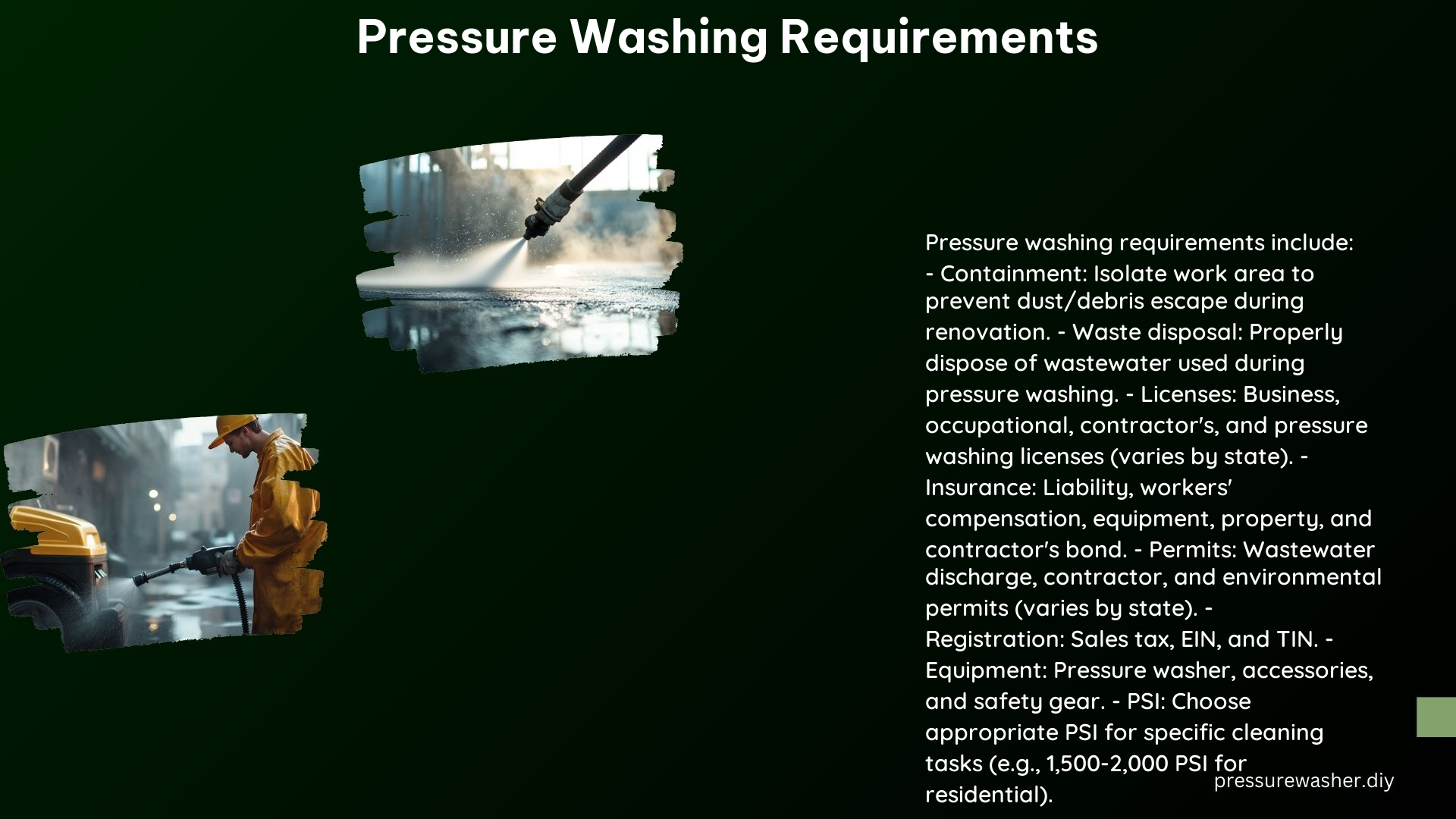Pressure washing is a versatile and effective cleaning method used for a wide range of surfaces, from residential homes to commercial buildings. However, starting and operating a pressure washing business requires adherence to various licensing, insurance, equipment, and environmental regulations. This comprehensive guide delves into the key requirements and technical specifications to ensure a successful and compliant pressure washing operation.
Licensing and Insurance Requirements
Licensing
- Pressure washing businesses typically require a business license, occupational business license, and contractor’s license to operate legally.
- Some states, such as New York, have specific licensing requirements for pressure washing services, which may include obtaining a Home Improvement Contractor License or a Specialty Trade Contractor License.
- The licensing process can vary by state and local jurisdiction, so it’s essential to research and comply with the specific requirements in your area.
Insurance
- Liability insurance is a crucial requirement for pressure washing businesses, providing coverage for property damage, personal injury, and other claims.
- Workers’ compensation insurance is mandatory in most states to protect employees in the event of work-related injuries or illnesses.
- Equipment insurance is necessary to cover the replacement or repair of pressure washers, accessories, and other specialized equipment.
- Property insurance protects the business’s physical assets, such as the facility, vehicles, and storage areas.
- Additionally, contractor’s bonds and income protection insurance may be required in some jurisdictions.
Equipment and Safety Requirements

Pressure Washer
- Pressure washers used for pressure washing services typically operate between 1,000 and 4,000 PSI (pounds per square inch).
- The appropriate PSI level depends on the specific cleaning task:
- 1,000-2,000 PSI: Suitable for light-duty cleaning, such as washing cars, patio furniture, and windows.
- 2,000-3,000 PSI: Ideal for medium-duty cleaning, including siding, driveways, and decks.
- 3,000-4,000 PSI: Recommended for heavy-duty cleaning, such as removing stubborn stains, grease, and mildew from concrete or masonry surfaces.
- The flow rate, measured in gallons per minute (GPM), also plays a crucial role in cleaning efficiency and speed.
Accessories
- Surface cleaners: Specialized attachments that provide a wider cleaning path and more even coverage.
- Undercarriage cleaners: Designed to clean the hard-to-reach areas underneath vehicles.
- Nozzles: Interchangeable tips that allow for adjusting the spray pattern and water pressure.
- Brushes: Used for scrubbing and agitating surfaces to enhance cleaning effectiveness.
- Hoses: High-pressure hoses that can withstand the pressure and temperature of the water.
- Safety gear: Gloves, goggles, boots, and other personal protective equipment (PPE) to prevent injuries.
Safety Precautions
- Proper training and use of safety gear are essential to prevent injuries and property damage.
- Pressure washers can cause serious injuries if not used correctly, so operators must be trained in safe handling and operation.
- Establishing and enforcing safety protocols, such as maintaining a safe distance from the cleaning surface and avoiding direct contact with the high-pressure water stream, is crucial.
Environmental and Containment Requirements
Containment
- Pressure washing is subject to the same containment requirements as other renovation practices, such as lead-based paint abatement.
- The work area must be isolated to prevent dust, debris, and wastewater from leaving the site and contaminating the surrounding environment.
- Containment measures may include the use of tarps, barriers, and other physical barriers to contain the work area.
Wastewater Disposal
- Proper disposal of wastewater used during pressure washing is essential to comply with environmental regulations.
- The wastewater may contain contaminants, such as dirt, chemicals, or heavy metals, and must be disposed of in accordance with local water treatment authority guidelines.
- In some cases, the wastewater may need to be collected, tested, and treated before being discharged into the sewer system or other approved disposal methods.
Business Plan and Permits
Business Plan
- A comprehensive business plan is crucial for the success of a pressure washing business.
- The plan should include detailed information on fixed and variable costs, marketing strategies, organizational structure, and financial projections.
- Careful planning and budgeting can help ensure the long-term viability of the pressure washing operation.
Permits
- Depending on the state and local regulations, pressure washing businesses may require various permits, such as:
- Wastewater discharge permits: Necessary for the proper disposal of wastewater generated during pressure washing.
- Contractor permits: Some jurisdictions require specific permits for pressure washing contractors.
- Environmental permits: Certain pressure washing activities may require permits related to environmental protection and compliance.
Additional Considerations
Seasonality
- Pressure washing businesses can be seasonal, with peak activity during the warmer months when outdoor cleaning is in high demand.
- Operators should plan for fluctuations in workload and revenue throughout the year and adjust their business strategies accordingly.
Reputation
- Building a strong reputation through quality work, customer satisfaction, and adherence to industry best practices is crucial for the long-term success of a pressure washing business.
- Positive word-of-mouth, online reviews, and a commitment to professionalism can help attract and retain customers.
By understanding and complying with the various licensing, insurance, equipment, and environmental requirements, pressure washing business owners can ensure a successful and compliant operation. This comprehensive guide provides a solid foundation for navigating the complex landscape of pressure washing requirements and positioning your business for long-term growth and success.
References
- Levelset. (n.d.). Do I need a licence and insurance to do small residential powerwashing jobs in New York state (not NYC)? Retrieved from https://www.levelset.com/payment-help/question/do-i-need-a-licence-and-insurance-to-do-small-residential-powerwashing-jobs-in-new-york-state-not-nyc/
- EPA. (2024). How do RRP requirements apply to pressure washing? What containment and other preparation are required? Retrieved from https://www.epa.gov/lead/how-do-rrp-requirements-apply-pressure-washing-what-containment-and-other-preparation-are
- Pressure Washers Direct. (n.d.). Water Pressure PSI Guide – How to Choose the Right PSI for Your Pressure Washer. Retrieved from https://www.pressurewashersdirect.com/stories/1395-How-to-Choose-the-Right-PSI-for-Your-Pressure-Washer.html
- NortexSS. (2023). What Do You Need To Start A Pressure Washing Business. Retrieved from https://nortexss.com/blogs/nortexnews/what-do-you-need-to-start-a-pressure-washing-business
